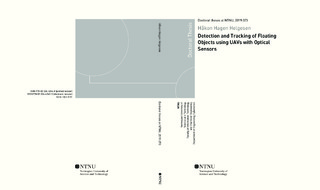| dc.description.abstract | This thesis focuses on detection and tracking of floating objects using fixed-wing unmanned aerial vehicles (UAVs) equipped with a monocular thermal camera. UAVs with optical sensors are useful in a vast number of applications such as search and rescue, inspection, target tracking and surveillance. The usefulness of UAVs in remote sensing applications is going to increase in the future so further research on these topics is needed.
The main motivation behind this work was to identify and develop suitable realtime algorithms for detection and tracking of objects located on the sea surface. Moreover, real-time performance on small embedded computers was desired and used as a guideline. Much work has been carried out to study detection and tracking on stationary platforms, but less work has been conducted to find methods that fit the operating envelope of fixed-wing UAVs. This thesis aims to provide new insight into detection and tracking, and handle issues that arise from rapid camera motion.
Another objective was to provide new insight through analysis of experimental data. The majority of the results presented in this thesis are based on experimental data that have been collected in several independent field experiments. A huge effort was made to plan and conduct these experiments, both with regard to payload development and mission design. It is hard to simulate detection and tracking in a realistic manner because some of the most prominent issues are difficult to recreate in simulations. Therefore, a goal was to collect much experimental data and process the data using different methods. Obviously, this has influenced the direction of this work because issues revealed along the way have been prioritized and investigated later in the research period.
Tracking and georeferencing of floating objects have been the main tasks studied in this thesis. Consequently, some of the methods are tailored for these applications. Nevertheless, the methods are also applicable for complementary missions with changes to smaller parts of the system. The experimental analysis has focused both on empirical and theoretical aspects. Improving the accuracy of existing systems has been desirable, but concepts such as optimality and consistency of tracking filters have also been central.
Target tracking is usually divided into three subproblems, namely detection, data or measurement association, and filtering (state estimation). Detection concerns identification of objects within a sensor scan. Object detection in images involves identifying pixels that belong to objects. It is traditionally solved with image processing techniques and more recently with machine learning. The filtering part of target tracking deals with estimation of target states, typically the position and velocity. The filtering part utilizes image detections to improve and correct the predicted states. Measurement association is needed when multiple targets are present in the surveillance region or when clutter and false detections are expected. New detections are related to existing tracks through data association. This thesis looks into every part of the tracking system, but focuses particularly on filtering and state estimation.
The first part of this thesis consists of three chapters which give a fundamental introduction to remote sensing applications, UAVs, optical sensors and target tracking. Research objectives and goals are stated together with description of related and existing work. Chapter 4 to Chapter 7 investigate detection in thermal images, georeferencing of thermal images, and target tracking. Navigation uncertainty influences georeferencing and target tracking in a negative way so one chapter is devoted to tracking in the presence of navigation uncertainty. These four chapters consist of several methods in addition to numerous case studies that investigate the effectiveness of these methods. The thesis also touches upon navigation for UAVs because errors in the UAV pose is a bottleneck with respect to the accuracy and performance of the tracking system. The final part of the dissertation concludes the results and discusses future possibilities. | nb_NO |
